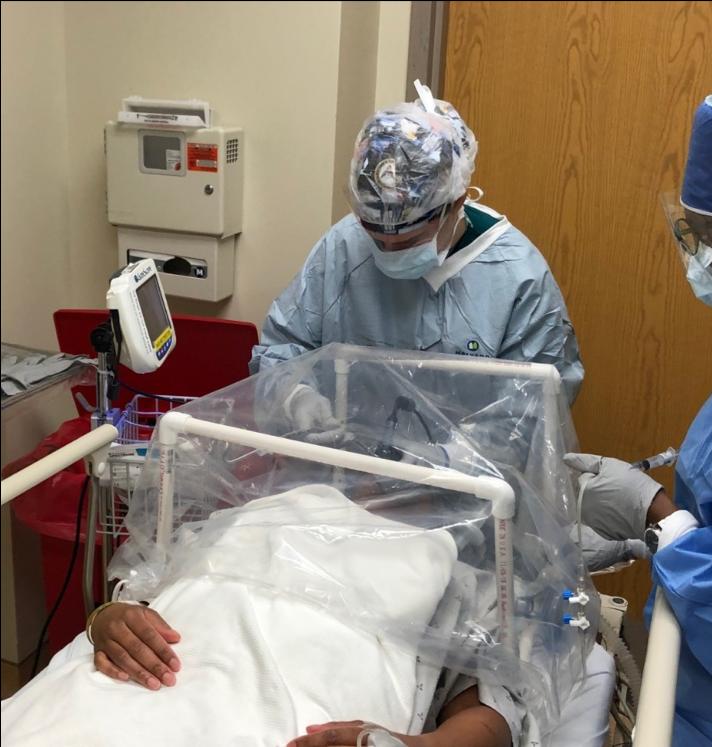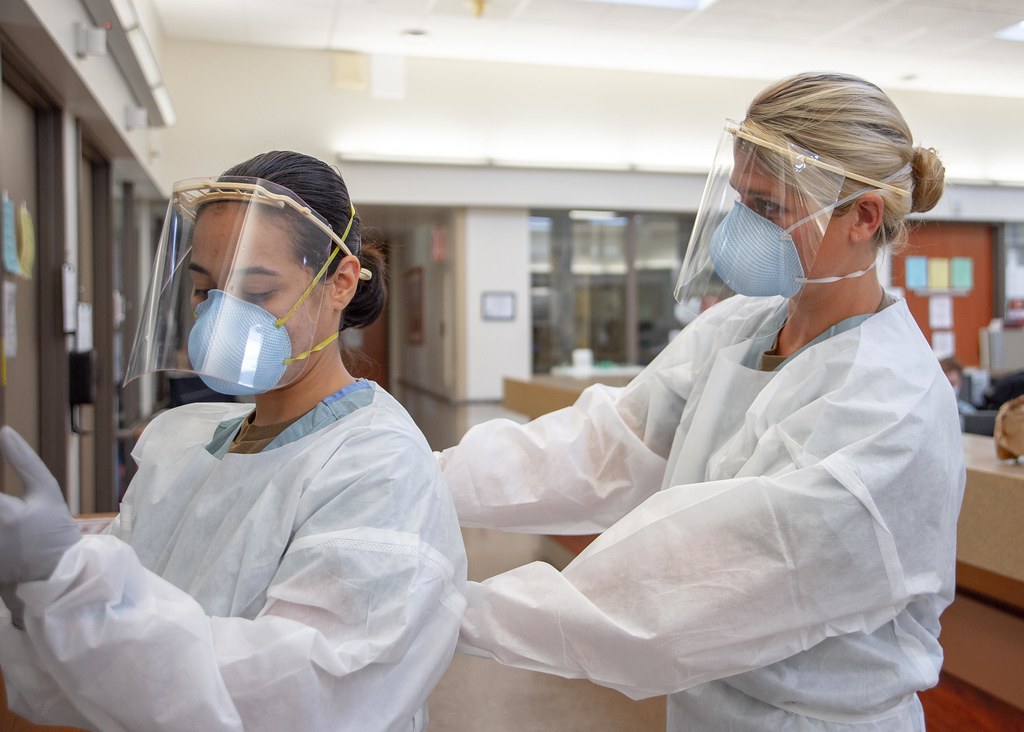15
Grace Towe
Introduction
Throughout the years, society has always relied on science to keep the population safe and healthy. On the other hand, science has always relied on itself in order to make sure that the decision and inventions that were created were to the best intentions for society. When COVID-19 infected a good majority of the population within months, scientists knew that they needed to develop new and improved technology to ensure humanity is safe. With the impact of COVID-19 hitting the entirety of the world so quickly, scientists and inventors have dedicated their work to update equipment and create new inventions to keep healthcare workers safe, patients with COVID-19 healthy, and reduce the spread of COVID-19. One of the most important inventions that meet all of these goals that scientists have is called a COVID-19 Airway Management Isolation Chamber (CAMIC). The reduced spread of COVID-19 is attributed to the use of CAMIC devices during surgeries and in patient’s rooms along with the implementation of new policies to reduce the spread of COVID-19 in places such as hospitals and universities.
Connection to STS Theory
In order to create new types of technology, scientists had to rely on the past. Without past inventions, knowledge, and scientific articles, there would have been a delay in these new types of inventions. The last large-scale epidemic was the Spanish Flu, so scientists considered the medical policies from this virus. With the advancements over the last 100 years in technology, scientists were able to improve policies to properly fight against COVID-19. This is because scientists were able to look back on different types of models used in the past and recreate those models but to better efficiency. The theory where scientists use the past to mold new technology is called Path Dependency. Path Dependency “explains how history really matters – where we have been in the past determines where we currently are and where we can go in future. Even tiny, seemingly trivial differences in the path we have taken may have enormous consequences for where we are and can go” (Veenstra, 2018). It is essentially the influence that past consequences have on current decisions.
The Creation of the CAMIC Device
Shortly after the pandemic started, the FDA approved a COVID-19 Airway Management Isolation Chamber, also known as CAMIC. This device was designed to keep healthcare workers, specifically surgeons and operating room staff safe while they performed surgery on COVID-19 patients. Dr. Steven Hong states, “As he watched the COVID-19 crisis unfold across the world, Hong saw how it was overwhelming the healthcare systems in Italy and New York. He knew that COVID-19 was very contagious and healthcare workers, especially within his specialty of head and neck surgery where they are often exposed to nasal and respiratory droplets, seemed to be more vulnerable” (Military Health System, 2020). This led Dr. Hong to begin to think of ways to create a three-dimensional airway tent. The CAMIC device was created to act as a negative pressure vacuum, so it can contain and reduce the movement of aerosols and airborne particles. Although the CAMIC device does reduce the spread of COVID-19 during surgeries, like a tracheostomy, the healthcare workers would still need to wear their proper personal protective equipment during the procedure to still be safe. Therefore, using the CAMIC device during operations helps keep all of the medical personnel safe from the spread of COVID-19.
Voices of Clemson Undergraduate Students
“I can testify to these new policies that were put into place. I have seen them in action first hand, working at a hospital during the pandemic”

More Protection that the CAMIC Device Offers
Not only does the CAMIC device protect healthcare workers, but it also protects the patient with COVID-19. While wearing the device, the patient is safe from any hospital-acquired infection, an HAI. Custodio explains that “Hospital-acquired infections are caused by viral, bacterial, and fungal pathogens; the most common types are bloodstream infection (BSI), pneumonia (eg, ventilator-associated pneumonia [VAP]), urinary tract infection (UTI), and surgical site infection (SSI)” (Custodio, 2020). These types of hospital-acquired infections are unlikely to occur, but the CAMIC device will keep the patient safe from these infections. While the patient has the chamber on, the negative pressure system creates a barrier so that outside particles from nearby healthcare workers cannot enter their breathing airways. This keeps the patient safe from airborne particles traveling through air duct systems from other patients and medical personnel. So not only does the CAMIC system protect the medical personnel, but it also protects the patient from receiving other airborne viruses and transmitting COVID-19.
New Policies That Have Been Enforced
While infected COVID-19 patients can wear the CAMIC device to reduce the spread of the virus and protect the medical personnel, this device is not worn by non-COVID-19 patients and non-patients. Multiple policies and rules have been set in place at hospitals to reduce the spread of COVID-19 to protect healthy people. At the very beginning of the COVID-19 pandemic, it was mandatory for healthcare workers to wear surgical masks throughout their entire shift. If workers have COVID-19 positive patients, they are required to change their masks going room to room. Hospital systems enforced these policies quickly so that their healthcare workers were not getting infected by this virus and to protect healthy patients from the virus. Another policy that was implemented in hospitals in the upstate of South Carolina is that when you enter a COVID-19 patients room, healthcare workers are required to ask the patient to politely put their masks on so that their airborne particles are staying inside of their mask and not entering the airways of healthcare workers. Not only have hospitals been more cautious about this new virus, but universities across the nation have also made changes. When conducting COVID-19 swabs, Clemson University has become extremely careful for the safety of their students and faculty. Clemson has required healthcare workers to be gowned in personal protective equipment from head to toe for their safety and others around them. These healthcare workers sanitize their plastic gowns and change gloves between each student and faculty member that they come in contact with. Even the smallest policy implemented in hospital systems and universities will reduce the spread of COVID-19 and protect all patients and faculty.
Clemson’s Response: COVID Challenge
In the midst of the COVID-19 lockdown, many students found themselves jobless or without an internship in the summer of 2020. The Clemson Covid Challenge (CCC) allowed more than 400 students to participate in virtual research which specifically addressed a variety of problems brought about by the COVID-19 lockdown. One of these projects was proposed by two freshmen who developed a UVC light that would be implemented to grocery store conveyor belts (Cooper, 2020). This light would kill the coronavirus and other viruses and pathogens, protecting essential grocery store workers (Cooper, 2020).

Conclusion
With the impact of COVID-19 hitting the entirety of the world so quickly, scientists and inventors have worked tremendously hard to update equipment and create new inventions to keep healthcare workers safe, patients with COVID-19 healthy, and reduce the spread of COVID-19. The CAMIC device was created to keep healthcare workers, patients, and healthy individuals safe from the virus. Without the past inventions of isolation chambers or the knowledge from the Spanish Flu outbreak, scientists would not have been able to create and build the CAMIC device so quickly and successfully. Although the Spanish Flu was 100 years ago, scientists analyzed the data and applied that knowledge to COVID-19 because both are viruses and transmit similarly. With that being said, the CAMIC device successfully protects patients and staff during surgeries and the new policies that hospitals and universities have implemented are also keeping everyone safe from the spread of COVID-19.
References
Amina Khan. (March 31, 2011 Thursday). FATA: voice of the unheard – path-dependency and why history matters. Strategic Studies. Retrieved from https://advance-lexis-com.libproxy.clemson.edu/api/document?collection=news&id=urn:contentItem:53Y1-NS61-DY8G-X438-00000-00&context=1516831
Clemson COVID Challenge. (n.d.). Retrieved April 18, 2021, from https://www.clemson.edu/centers-institutes/watt/creative-inquiry/clemsoncovidchallenge/students.html
Cooper, A. (2020, May 11). Clemson students create device that could Combat Covid-19 at the grocery store. Retrieved April 18, 2021, from https://greenvillejournal.com/health/clemson-students-create-device-that-could-combat-covid-19-at-the-grocery-store/
Custodio, H. (2020, May 03). Hospital-Acquired Infections. Retrieved November 08, 2020, from https://emedicine.medscape.com/article/967022-overview
Military Health System. (2020, July 9). Defending the Homeland: New Invention Helps Protect Healthcare Workers During Covid-19 Pandemic. https://health.mil/News/Articles/2020/07/09/New-Invention-Helps-Protect-Healthcare-Workers-During-Covid-19-Pandemic
Images
Image 1: “Isolation Chamber Invented by Army Doctors Protects Staff from Pathogens” by Global Biodefense Staff is licensed under CC BY 2.0
Image 2: “Medical personnel don PPE before entering a COVID-19-positive, non-critical patient’s room.” by Official U.S. Navy Imagery is licensed under CC BY 2.0

